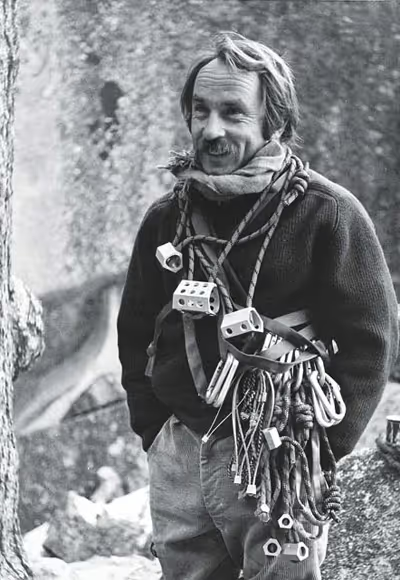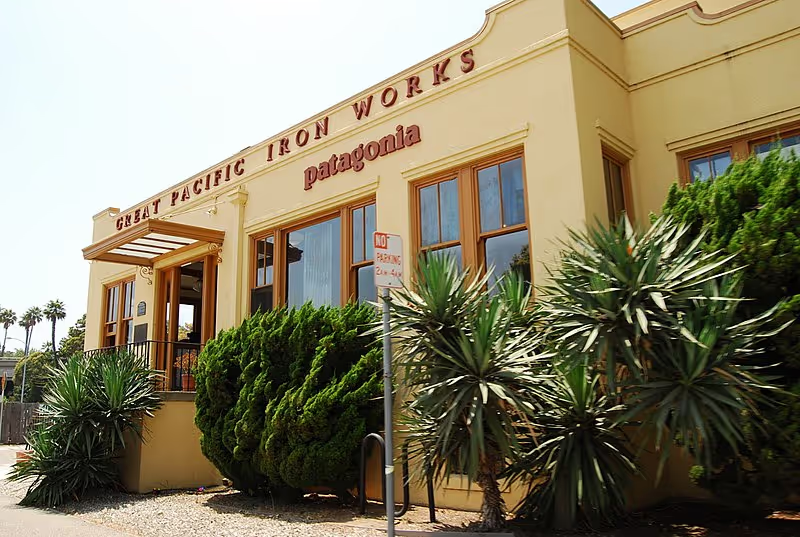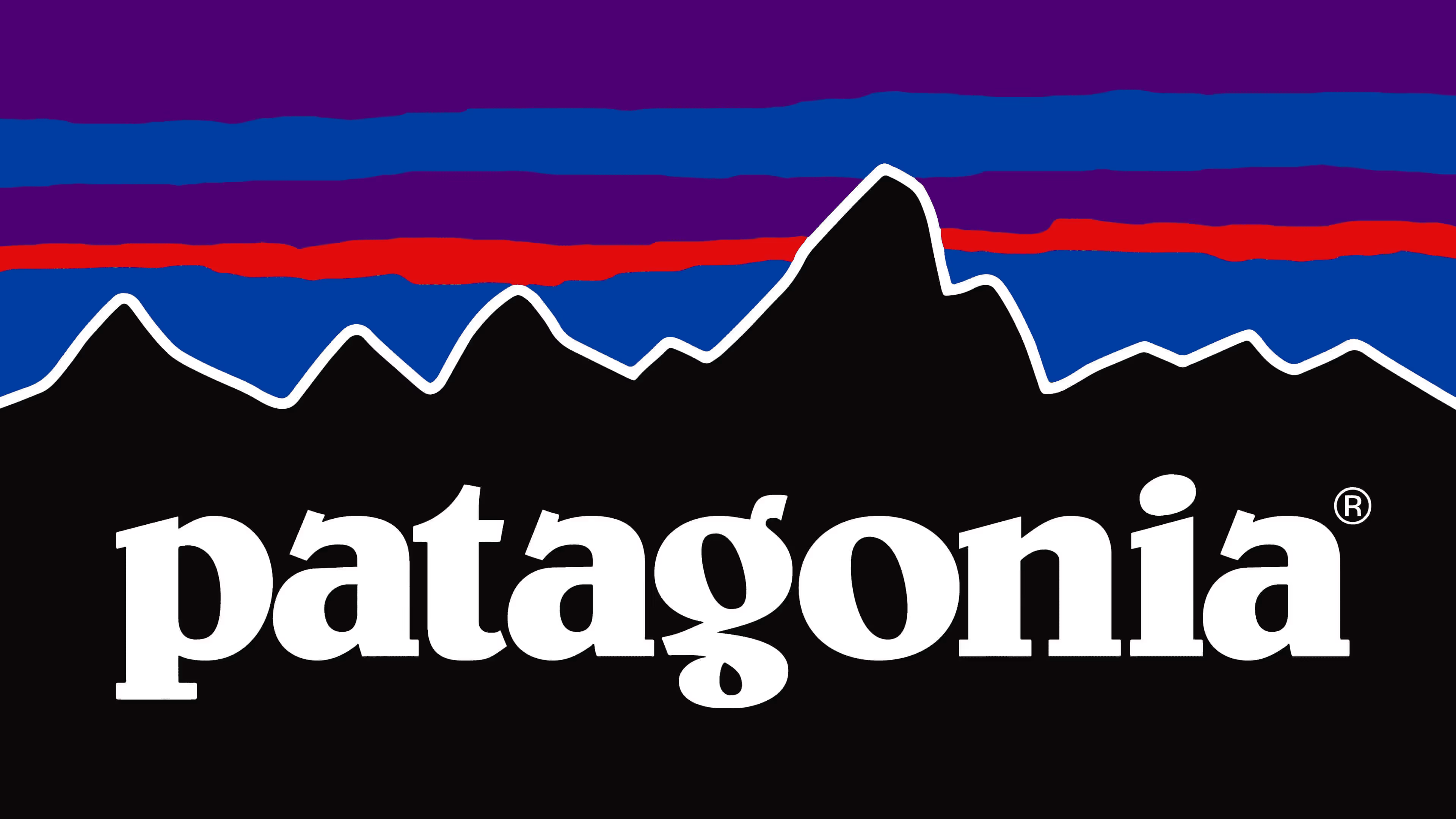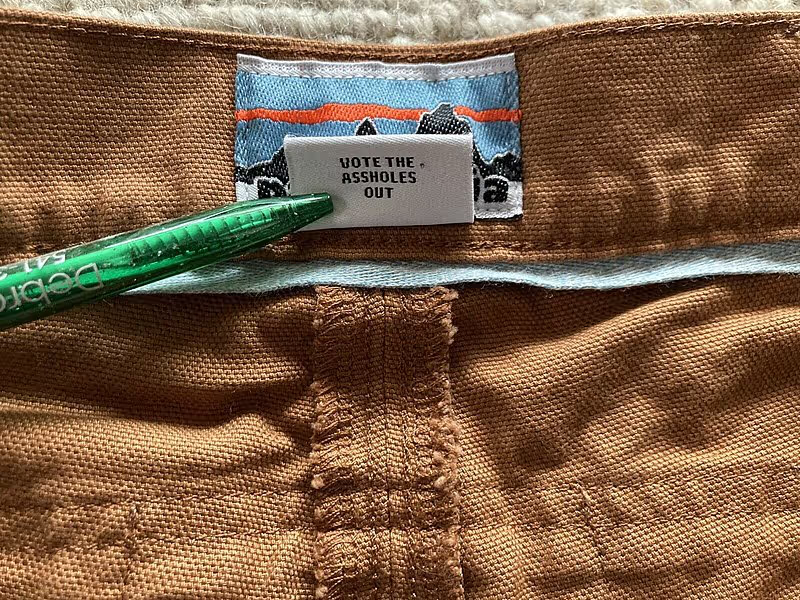The trendy outerwear brand that is loved by millions didn’t initially start out in clothing but surpassed $1 billion dollars in annual revenue back in 2017, largely due to the brand’s environmental initiatives and popularity amongst outdoor enthusiasts. With its ever-growing evolution and creative business approach, Patagonia has evolved into a retail giant and advocate for sustainable business practices.
Key Patagonia statistics showcasing growth over the last 50 years:
- On September 14, 2022, Patagonia announced its new corporate structure giving away 98% of its stocks on a non-profit
- 100% of electricity in its US facilities is from renewable sources
- 98% of Patagonia's product lines use recycled materials
- More Than 70 Patagonia Stores Worldwide
- #1 Market Share Holder in the Outdoor Apparel Market (near 10%)
- Spends less than $100 Million on advertising (digital and print)
- Since 1985, Patagonia has donated 1% of its profits to grassroots environmental groups (Sum: $140 Million)
- Over 2000 Employees Worldwide
Throughout the course of this article, we’ll cover Patagonia’s early influences and the history of how the brand came to be, as well as map out the attributes and executive decisions that built the billion-dollar eco-brand we all know and recognize today.
Passionate Rock Climber to No. 1 Climbing Equipment Supplier in 20 Years
Back in the 1950s, a young teenager by the name of Yvon Chouinard joined the Southern California Falconry Club. Through this club, Yvon developed a passion for rock climbing and it soon became a driving force in his life. By 18, Yvon was learning to craft and create his own rock climbing equipment, which soon grew to be a small backyard business at his parent’s house.
Yvon taught himself to blacksmith, handmade each product, and was having incredible success with his small business. However, the demand for Yvon’s products quickly outpaced his ability to hand-craft each piece. In less than a decade, Yvon had formed a strategic partnership that allowed him to mass-produce effective climbing equipment.
Just 13 years after Yvon began his blacksmith journey, Chouinard Equipment was the leading manufacturer of climbing equipment in the US.

Growing up in a humble French Canadian family in America in the 1940’s, Yvon experienced hardship and escape that ultimately would contribute to his entire career and impact generations. While Yvon had no aspirations of becoming an entrepreneur, his drive for exploration and adventure drove him to create a career that adapted to his lifestyle. Throughout the early years of Chouinard Equipment, when Yvon was still hand-crafting gear, he would make products throughout the winter and curb his urge for adventure during the summer. This work-life balance value that so deeply plagues Yvon Chouinard would go on to serve as the progressive company culture mission that Patagonia’s employees benefit from today.
Key takeaway
Yvon Chouinard’s decision to build a life around his passion would eventually lay the groundwork for the employee vision of Patagonia. While he was just a kid with no business experience, Chouinard’s ability to identify a problem or a hole in the market and develop a solution would serve as the product development approach for the two businesses he built over the following decades.
Chouinard Equipment Adds Clothing to Their List of Specialty Outdoor Gear
When Chouinard was ready to expand his backyard business, he took his proposal to his friend, fellow rock climber, and engineer, Tom Frost. The two would create Chouinard Equipment, Ltd and begin to set precedents for the entire outdoor industry. Both passionate and educated, the duo began focusing more heavily on improving the quality and function of their products, obsessing over even minor details. Perhaps ahead of their time, Frost & Chouinard’s attention to detail and product quality would quickly drive Chouinard Equipment to the top of the industry.
Product development & marketing
It was in Chouinard Equipment’s first 1972 catalog that would set the beginning of the brand tone of Patagonia in the coming years. The first of its kind, the climbing gear catalog championed the planet and called on ethical climbing products that would not damage the mountains (as other carabiners did). The catalog was filled with inspirational quotes and thought-provoking information while marketing the climbing gear sold by Chouinard Equipment.

Frost and Chouinard’s marketing approach worked better than expected and again, demand was becoming difficult to meet. While sales skyrocketed and the marketing achieved the intended effect, perhaps more notably important is the influence the educational approach had on consumers. The message effectively reached and resonated with the climbing community, causing many people to cite reading the catalog as a defining moment in their climbing journey.
As the outdoor gear industry began to grow in the 1970s, Chouinard recognized an opportunity for expansion and so began the company’s experimentation with outdoor clothing and storefronts. By 1975, Chouinard was well on his way to expanding into textiles, but Tom Frost was not on board. The disagreement on the future of the company eventually led to the dissolution of the partnership between Frost & Chouinard and Chouinard began to take the company where he thought it should go.
Chouinard Equipment Product Development Timeline —
The Great Pacific Iron Works —
First opened in 1973 with just 12 employees, the store is still up and running in Ventura, California, and is regarded as Patagonia’s first ever storefront. Here, climbers and outdoor enthusiasts could find a collection of highly-thought out textiles that were eco-conscious and perfect for the outdoors.

Year after year, Patagonia released new styles of outdoor fashion pieces to be sold at Great Pacific Iron Works, and year after year the company produced a multi-million dollar increase in sales, reaching $5 million per year by the time of the company’s Chouinard Equipment incorporation in 1982.
Patagonia Clothing Release Timeline —
After the incorporation of all three companies in 1982 (Patagonia, Chouinard Equipment, and Great Pacific Iron Works), the outdoor gear giant continued to lean into its missions of “clean climbing,” sustainability, and environmental protection. Through the rest of the decade, innovation of product design and increasing sales would inspire big changes for the future of Chouinard Equipment and Patagonia.
Key takeaway
Chouinard’s initial decision to implement environmental messaging into the Chouinard Equipment catalog would serve as Patagonia’s entire marketing strategy in the years to come. Not only did his messaging leave a lasting impact on readers of the catalog, but it spurred eco-conscious product development that is the leading priority—and cause of success—of Patagonia today.
Rapid Growth and Bankruptcy for Chouinard Equipment
Since the formation of Chouinard Equipment, it was apparent that the company leadership would be a unique participant in the market. The first American outdoor gear supplier of their kind, Chouinard went on to lead with fearless abandon. In an effort to draw attention to climate change in a time where no one had really done so, Chouinard began to use his company in conjunction with that mission.
This strategy applied for Patagonia as well and has grown as much, if not more, success as it did in the 70s & 80s when it was first implemented. Even before full-fledged environmental efforts were a prominent part of the company culture, innovation was present. After Chouinard’s success in tool design, he went on to develop cutting edge, sustainable clothing options that no one had really seen before.

With his creativity came the Patagonia color integration of the 1980s. Throughout this time, Patagonia ran a color campaign where every style was available in vibrant color options. The line featured knockout colors like teal, seafoam, deep red, and powder blue. In these busy years of product supply and demand, Patagonia’s sales had reached the millions and the company was named “Fastest Growing Company” by Inc. Magazine.
1989 —
Due to unfortunate climbing accidents and company lawsuits, Chouinard Equipment was forced into bankruptcy. An investor group purchased the assets for $900,000, rebranded the company as Black Diamond Equipment, and Yvon Chouinard was free to focus solely on thriving Patagonia.
1991 —
Despite the historical success Patagonia had over the last decade, they were not immune to an economic recession and the pitfalls that come along with it. By June of 1991, Patagonia had become Ventura, California’s fourth-largest employer. While the company growth was a clear indication of Patagonia’s success, it was a wake-up call for the company when they were forced to fire 20% of their entire workforce in July.
As Patagonia worked to recover from the economic downturn of 1991, it did not lose sight of its commitment to environmental impact and continued to develop strategic partnerships with manufacturers that aligned with the Patagonia vision. Patagonia executives managed to rescue the company from near dissolution and emerged a stronger brand with a clear identity. Going forward, the company would lean heavily into philanthropic causes and sustainable product development.
It was during this time that Patagonia would lead work culture and environmental initiatives that would separate the company from every traditional business—yet again—and mark the beginning of the climb to the retail giant we know today.
Key takeaway
While Chouinard Equipment was the first business of Yvon Chouinard, his decision to sell the company and focus on Patagonia contributed to the success of the brand through the 80s.
With bold industry moves like the Patagonia color palette introduction that still has a strong presence in the brand today, the company gained great recognition in the apparel industry.
Patagonia's Commitment to the Environment and its Employees
Patagonia had been making progressive decisions since its founding but as the years went on, it became clear that the company would continue to enlist progressive initiatives and make it apparent that they care about their teams and their planet.
Decades ago, environmental impact information wasn’t as easily accessible as it is today and while Patagonia was aware, the leaders of the organization began to become more aware of the environmental crisis. In the early 1970’s, a developmental debate arose in Ventura, CA that would demolish what was left of the Ventura River and threaten any wildlife that lived there. It was in a partnership with a young biologist to save the river that Patagonia became fully inspired and committed to becoming a revolutionary company that would try to save the world.
The combined efforts of biologist Mark Capelli and Patagonia would form a community coalition to protect the Ventura River, called “Friends of the Ventura River.” The coalition is still in action today and receives conservation sponsorships from groups like Patagonia, the Ventura Visitors and Convention Bureau, and BioResource Consultants in Ojai.

Patagonia’s commitment to the environment
In 1986, the company made its first sustainability commitment. With this initiative, Patagonia pledged 1% of total sales or 10% of total profit each year would be donated to environmental non-profits and advocacy groups. Nearly 40 years later, Patagonia has honored this commitment each and every year, having donated over $100 million dollars to environmental agencies.
While Patagonia does continuously donate a portion of its revenue to environmental causes, they don’t stop there. For decades Patagonia has sponsored grants, used its influence to inspire change, and championed grassroots movements in an effort to contribute to environmental protection at every turn.
Yearly, beginning in 1988, Patagonia also campaigns around a specific environmental issue to raise awareness and effect change. The first initiative was an effort to De-Urbanize Yosemite Valley, another was the Globalization of Trade. Patagonia has poured money and time into creating a widespread education campaign on various environmental impacts for the last 30 years, inspiring up-and-coming entrepreneurs to look through business with an eco-conscious lens.
Today, Patagonia is connecting activism and activists by promoting relevant cause information on their dedicated campaigns webpage: Patagonia Action Works. With quick access to factual information about the supported causes and detailed information on how to get involved, Patagonia is compounding its ability to help the world by giving the tools to the masses. Currently, the brand is promoting the following education campaigns:
- Build Back Fossil Fuel
Spread awareness about fossil fuels' effect on climate change and indigenous cultures.
- 30 by 30 Resolution to Protect Nature
A commitment to legally protect 30% of our global land and water by 2030.
- Environmental Justice is Racial Justice
Commitment to invest in and amplify frontline groups.
- Public Lands and Waters Are Under Threat
Coalition of Native American Tribes, Businesses, Conservation Groups, and Citizens to Unite Against Government Interference with Public Land/Water
- Support the Boundary Waters Wilderness Act
Spread awareness about copper mining and its toxicity.
- Protect the Arctic and Stand with the Gwich’in
Uniting citizens to protest development and oil drilling on the coastal plain of the Arctic National Wildlife Refuge.
By 1996, the company was making faster and more polarized movements in activism and environmental change. During this time, the company was the first to make the switch to all-organic cotton, as well as the first to use recycled plastic bottles to manufacture recycled polyester. Polyester manufacturing has a detrimental effect on the environment and is a large proof point in the debate against fast fashion. As of 2021, 84% of the polyester used to make Patagonia clothing is made from recycled polyester.
In the same year, Patagonia opened a new distribution center in Reno that reduced energy use in the facility by more than half. A strategic deployment of capital into energy-saving components, combined with recycled or retrofitted materials led Patagonia to develop one of the most eco-conscious development builds of its time.
Along with everything listed above, Patagonia also holds bi-yearly education conferences for activist groups. At the conference, Patagonia representatives share what they’ve learned about marketing, education initiatives, and strategic maneuvers that can help non-profits get more visibility and traction for their mission. The Tools for Grassroots Activists Conference is in its 12th year and “mini” tools conferences have begun to take shape across multiple Patagonia locations.
Patagonia’s commitment to employees
About 10 years after Patagonia’s formation in the early 1970’s, Patagonia invested in an employee focused initiative that would set the tone for the entire company culture as the years went on. In 1983, Patagonia began to offer on-site childcare to their employees to improve their company morale. The initiative has been a long-time favorite perk of Patagonia employees and recent studies have shown that employee turnover is 25% lower when parents have children that attend the facility. Not only does the company focus on parent convenience and comfort, but they offer paid maternity and paternity care to all new parents.
Not long after the first childcare program was introduced, Patagonia invested in an employee cafeteria in Ventura that served healthy and organic food options. The principles of Patagonia have always been to respect and care for their employees, as they do for their planet, furthering the authenticity and effectiveness of the brand. At this point, they had not only done well with marketing to convince customers of their mission, but they had started the beginning of a company culture that was encouraged to continue to grow in originality.
Once the layoffs hit and Patagonia was in a particularly poor place, they began to invest more into their company culture and employee satisfaction—and the investment paid in dividends. While the 1991 layoffs were arguably the most difficult times the company has experienced, the lax and inviting culture got everyone through it. There were no office walls or strict dress codes, and company-sponsored ski trips were a token of appreciation from Patagonia to its employees.
In an ode to his love of the outdoors and a working work schedule, Yvon Chouinard created a “Let My People Go Surfing Policy” at Patagonia that gives employees the freedom to enjoy the outdoors on a whim, as well as an alternating weekly schedule that gives each employee every other Friday off.

Not only has Patagonia continuously shown their value for their employees, but at a time when the entire world was out of work and revenue during the lockdowns of 2020, Patagonia continued to pay their employees and only spoke to the collective responsibility of protecting each other from the virus.
The company culture at Patagonia clearly works and is favored by the employees. The company has a surprisingly low employee turnover rate of only 4%—the national average is five times that and the majority of companies don’t make the effort that Patagonia does. With 46% of employees citing company culture as a workplace value, companies that struggle with high turnover rates would do well to learn from Patagonia.
Key takeaway
Patagonia’s decision to innovate even more after the 1991 layoffs led the company to more growth than it had ever seen, and the company continues to see that growth year after year. The brand’s early focus on ethics-centric business practices and open-mindedness set them apart from a generation of businesses and inspired the businesses of today to approach business with an ecological and social equity mindset.
Patagonia Calls Out Inequity, Politics, and Unaligned Partnerships
Sure of their voice and their stance on the issues of the world, Patagonia has made it a point to speak out about the issues they believe in—even those beyond climate change. While this approach has worked for Patagonia for decades, executives are only recently beginning to understand that companies today must lead with purpose. Studies have emerged that suggest that 62% of customers want companies to advocate for social issues, which explains why Patagonia’s intuitive marketing style has been so successful.
Patagonia has taken a refreshing approach to issues of politics and business partnerships, making it a point to release all unaligned connections from the brand. This means vetting manufacturing companies and ensuring that they comply with Patagonia’s commitment standards or writing a donation check for the amount of a tax break.
Another area where Patagonia has not been shy to voice its stance on the matter is in politics. When Trump imposed a tax cut in 2018 that resulted in the company profiting $10 million dollars, Patagonia donated the entire sum to climate groups and deemed the tax cut “irresponsible.”
In an effort to protect the conditions of migrant workers at Patagonia partner facilities in other countries, Patagonia has been working over the last decade to ensure that these employees are receiving fair treatment and conditions from the hiring process to every day on the job.
Patagonia’s Social Responsibility Program requires that the brand stay true to its mission, and so do its partners. Whether it’s employee conditions or brand alignment, Patagonia has made it a responsibility to distance itself from partnerships that aren’t eco-conscious and speak out for issues that need a platform—regardless of the consequences. Patagonia doesn’t pander to those that don’t agree with the company’s business practices. After a Planned Parenthood donation in the 90s, the company received negative feedback from angry traditionalists. As the riled calls came in, reps at Patagonia informed callers that a $5 donation would be made to Planned Parenthood for every call.
Following the upheaval and political divide that was present in the entire year leading up to the 2020 Presidential elections, Patagonia took another bold step in activism as they creatively encouraged their customers to vote by embroidering it in their clothing.

It’s displays of realism like this one continues to make Patagonia an icon in the retail world.
The Patagonia Vest debacle
As the brand grew, it began to evolve into a white collar leisure uniform of sorts. From pullovers to t-shirts, Patagonia offered a style range to men that hadn’t really been done before. Because of the high price point and the type of clothing Patagonia offers, the majority of the customer base has always been male.
With the introduction of the fleece vest and its ability for the office, a “Power Vest'' trend amongst middle-aged businessmen arose. Noticing this trend, Patagonia began to pull back and restrict its offerings to corporate clients, as the vest was becoming a symbol of something not quite aligned with any of Patagonia’s ongoing missions.
The company stated it would be focusing on working with Certified B Corporations, or corporations committed to sustainable practices. This was a polarizing stance that may have cost them a considerable amount of revenue from past clients but Patagonia does not care. The health of the planet is the number one priority and Patagonia is setting precedents in the world of business relations—if you’re not prioritizing the planet, the company doesn’t want your business.
Tin Shed Ventures
To further the reach of the retail brand and the Patagonia network, the company became a Venture Capitalist. In 2013, Patagonia, Inc formed Tin Shed Ventures, a venture capital fund that would invest in innovative start-ups that align with Patagonia’s mission to “save our home planet.”
With $20 million and only the goal of affecting positive environmental and social change, Tin Shed Ventures began to work behind the scenes to advance the Patagonia mission.
To date, Tin Shed Ventures has nine partnerships with up-and-coming startups of all industries.
- Wild Idea Buffalo—Raises 100% grass-fed buffalo in a way that restores the grasslands of the Great Plains.
- TERSUS Solutions—A water-less laundry solution that uses less energy.
- Bureo—Cleans up fishnets in South America to repurpose as valuable goods.
- Cairnspring Mills—A milling company that contributes to farming and agriculture.
- Beyond Surface Technologies—Swiss textile company that only uses raw materials.
- Solar Funds—Solar panel company to reduce overall energy usage.
- Trove—Platform that encourages recirculating old apparel back into the economy.
- California Safe Soil—Creates organic fertilizer from supermarket food waste.
- NuMat Technologies—Research company to optimize energy usage.
It’s apparent that Patagonia is using every tool at its disposal to make real change across our communities and our planet. From simply speaking out to putting millions of dollars into an idea, Patagonia has seemingly left no stone unturned when it comes to the effectiveness of the organization.
Key takeaway
Patagonia’s decision to speak out for the causes they believe in, as well as truly invest in and promote these causes, contributed greatly to the brand recognition of the company. By deploying capital into advocacy campaigns, the company has been able to effectively contribute to environmental and social issues, while gaining the intended results of typical ad spend.
Patagonia Marketing Strategy & Success
Brand transparency, consistency, authenticity, purpose, and content are all important brand characteristics that are important to the modern-day consumer. Patagonia has managed to harness each and every one of these characteristics in its marketing.
Because the Patagonia brand identity is so clear, marketing specialists have a semi-simple job when deploying marketing for Patagonia. As any marketer would tell you: a business must be clear about who their customer is. Patagonia has reached a unique level of customer engagement by having a product that is appealing to men and women, or athletes and business professionals, mainly because of the business itself and less of the product.
By marketing its philanthropic efforts or running educational campaigns, Patagonia is deploying essential ad spend that serves a greater purpose. Similar to killing two birds with one stone, Patagonia is able to promote the causes they care about and gain brand recognition in return.
Similar to all aspects of the Patagonia business, marketing is not an area where innovation and creativity have been left in the dust. The company makes use of all modern-day marketing techniques, from social media promotion to partnering with brand ambassadors, to investing in short films or tours.
Over the last decade, Patagonia has taken steps to discourage consumerism, and oddly enough, the position has benefitted the company’s brand and sales image. In an effort to bring awareness to indulgent consumerism, Patagonia released a 2011 Black Friday ad that encouraged people not to buy Patagonia clothing or anything else they don’t need. Despite the plea, Patagonia sales did not falter and the retail powerhouse has gone on to donate 100% of Black Friday sales since 2016.
Key takeaway
Non-marketing ploys and a rejection of consumerism actually catapulted Patagonia into more success as loyal customers of the brand value the company mission and dedication to the planet. The decision to be a non-marketing company has made Patagonia more impactful and furthers the company’s ability to rally behind social causes.
Patagonia as an Industry Role Model
Patagonia’s not wrong about the planet and they haven’t been for the last 30 years. As awareness spreads and more businesses and individuals are making conscious decisions about where and how to shop, everyone should look to Patagonia for guidance on how to ethically live their lives.
The brand and company's commitment to the overall mission of saving the planet is what has built the success of the outdoor apparel brand over the last several decades. Patagonia was implementing ethical business practices long before it was cool to do so and has made reducing the company’s footprint a priority.
If more brands led with the clarity, passion, and dedication that Patagonia has, we would have a more engaged client base, a healthier planet, and more retail companies might be able to produce the success that Patagonia has.
With the company hosting several initiatives through 2025 and 2030, it’s safe to assume that Patagonia will not be changing its methodology anytime soon—unless it’s to decrease energy usage and maximize its awareness outreach.
An overview of Patagonia’s evolution
Learn from Patagonia's success
Patagonia paved the way for purpose-driven business long before purpose-driven business was the trend and the preference that it is today. Patagonia developed the brand recognition, customer loyalty, and ultimately sales numbers that the brand has because of the authenticity, genuineness, and dedication that is apparent in everything that the company does.
Over the last 50 years, Patagonia has been committed to consistently designing products that lessen the brand's environmental impact. This diligence contributes to Patagonia’s ability to charge premium rates for the brand’s products, the overall revenue growth of the company, and brand loyalty as consumers trust that Patagonia approaches product development with intention and consciousness.
Patagonia has had incredible success from its anti-marketing stance and rejection of consumerism. In a time when consumers don’t appreciate a hard sell, anti-marketing gives consumers a sense of realism and appreciation for brands. While Patagonia implemented one of the first anti-marketing campaigns with the “Don’t Buy This Jacket” ad, the continued spin of marketing through social cause awareness has furthered Patagonia’s brand recognition.



